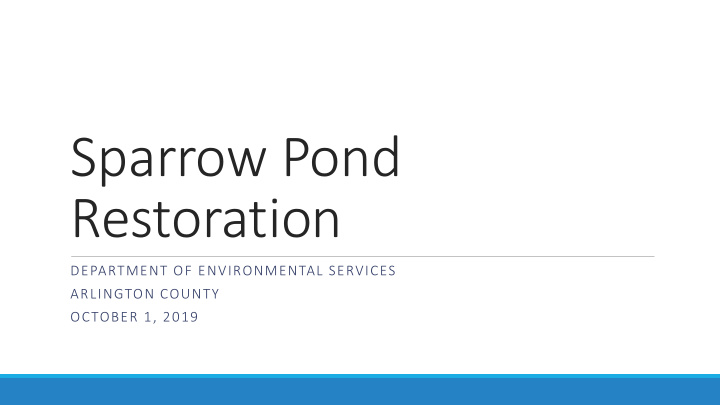



Sparrow Pond Restoration DEPARTMENT OF ENVIRONMENTAL SERVICES ARLINGTON COUNTY OCTOBER 1, 2019
Sparrow Pond Overview Background and Current Conditions Public Process Key Concerns from First Meeting Design Highlights Pond Wildlife (David Howell) Next Steps
Dog park Sp Sparrow P Pon ond Loc ocatio ion
Arlington Forest Sp Sparrow P Pon ond Loc ocatio ion Glencarlyn Barcroft Forest Glen Arlington Mill
Sparrow Pond Background 1990s: Assessment of “Sparrows Swamp” 2001-02: Pond areas were installed to provide habitat and water quality benefit 2003-2012: Pond fills in with sediment, cleaned out at least once 2012: Maintenance was deferred in favor of a redesign and restoration 2016: Feasibility study for restoration 2017-18: Embankment study and geotechnical analysis 2019-20: Design (30%, 60%, 90%, 100%) 2021-22: Construction (6-9 months)
Sparrow Pond Goals Goals of the restoration: ◦ Remove sediment to restore pond depths ◦ Add a sediment collection forebay ◦ Maximize water quality benefits ◦ Restore habitat for herons, ducks, turtles, frogs, fish Meet requirements and goals for Chesapeake Bay pollution diet and Stormwater permit Implement Stormwater Master Plan (2014) ◦ Improve existing, and add new, stormwater treatment facilities
Chesapeake Bay Pollution Diet • Timeline to reduce sediment and nutrients to the Chesapeake Bay • Next goals for 2023 and 2028 • Doing our part to protect the Bay – it’s working, but we can’t let up!
Drainage Area Total Drainage Area: 80.76 acres Forest/Open Space: 13 acres, 16% Turf: 35 acres, 44% Impervious Surface: 32 acres, 40%
2003 2005
2018
Design Process Fall 2020 Spring 2020 100% and Final Design Plan 90% design Finalize permits October 2019 Maintenance of Finalize maintenance Traffic agreement Planting plan 60% design March 2019 Pre Construction: More design Invasive species removal details 30% design Plant & animal rescue Wetland delineation Survey & Site analysis Utility investigation Hydraulic study
Key Concerns from First Public Meeting Wildlife Education Habitat Cyclists Trees Trails Plants Trash Access Porous Surfaces Maintenance
Design Highlights
Sediment Forebay Forebay traps sediment Allows sediment to settle out of the water column Facilitates maintenance Image: Virginia Best Management Practice Clearinghouse, 2011
Habitat Features Aquatic Benches http://grant-associates.uk.com/projects/suds-manual/
Access Path 10 foot wide access path next to W&OD trail Limit impacts on the trail 6” of gravel below surface
Permeable Surfaces Maintenance access path Vegetated surface, permeable sub-base
Expanded Pool Area Forebay Aquatic benches and other habitat features Provide more nutrient removal and water quality benefit Safely detain 100 year flood event (1% chance of happening each year) The new area was disturbed during the 2001-02 pond construction, used to deposit dredged sediment.
Tree and Wetland Surveys Trees were surveyed, mapped and classified Tree Preservation Priority Removals by priority (Initial figures) High Priority for Preservation 0* Factors for priority: Moderate Priority for Preservation 21 ◦ Species and habitat value Low Priority for Preservation 55 ◦ Condition ◦ Uniqueness Trees Not Recommended for Preservation 27 (11 dead, 1 critical, 15 poor) Next step: identify ways the design could be Total 103 adjusted to limit tree impact, especially with moderate priority trees * All high priority trees will be preserved. Tree and replanting information at next Wetland Studies and Solutions, Inc is supporting the meeting tree surveys, planting and wetland permitting work.
By request, this slide was added to the online PDF after the presentation was given. Preliminary (Draft) Tree Survey
Amphibian Breeding Habitat Looking to work with partners in Parks to identify potential frog breeding habitat area ◦ Would require temporary, shallow pools of water free of fish predators. Challenges: If inline with pond and stream, fish will be able to enter from the pond If not inline with pond and stream, the area will be fed by only runoff and may not accumulate enough water
Design Replace with public-friendly version – Jon is preparing
Input & Feedback What do you like about the design? What should we take into account moving forward? ◦ Suggestions or concerns What additional information would you like to see in 100% and Final Design Plan future meetings? 90% design Finalize permits Maintenance of Finalize maintenance Traffic agreement Planting plan 60% design Sign up to receive updates Pre Construction: Design details Invasive species removal Wetland 30% design Next Step: Design update meeting in Plant & animal rescue delineation Survey & Site analysis spring 2020 Utility investigation Hydraulic study
Census 2020 Questions? Lily Whitesell lwhitesell@arlingtonva.us 703-228-3042 Ty Asfaw, Project Manager tasfaw@arlingtonva.us 703-228-3959
Recommend
More recommend